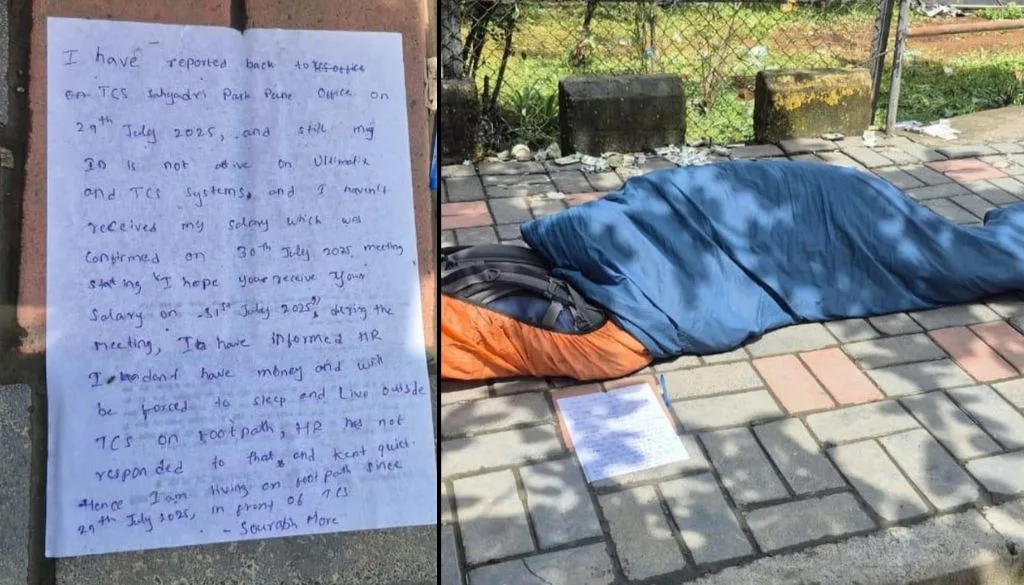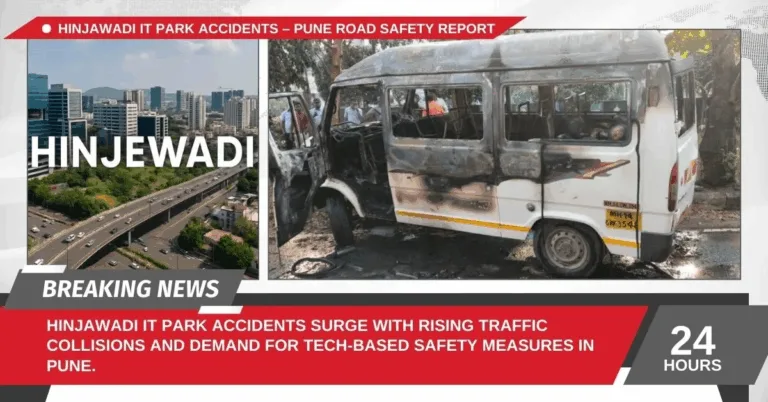
Ex-TCS employee Pradeep Narvekar protests on Hinjawadi footpath, demanding unpaid salary. Read the full story on puneripages.in
By Prashant for PuneriPages.in
On the concrete footpath outside Pune’s gleaming IT hub in Hinjawadi, a man sits cross-legged, holding his TCS ID card in one hand and a placard in the other. Behind him, corporate towers gleam with air-conditioned comfort, but he sleeps on the pavement.
The man is Pradeep Narvekar, a former employee of Tata Consultancy Services (TCS), who alleges that the company has withheld his rightful salary for over a year. His protest, carried out in the open amid Pune’s monsoon drizzle and public indifference, is a stark and deeply personal symbol of the silent battles that many workers fight within India’s vast IT machinery.
“I have no home, no money. I worked for TCS, and now I sleep on the road. Is this justice?” says Narvekar, pointing to the documents he carries in a crumpled folder beside him.
Table of Contents
His Allegation: Non-Payment and Silence
According to Narvekar, he worked in the TCS Pune office until 2023. He claims that following his termination, he was neither provided a clear explanation nor paid his dues. His repeated emails to the HR department, he alleges, were met with silence.
“They say I absconded. But I have proof I was present. I did my duty,” he says, showing screenshots of login records and emails.
He claims his final settlement, including pending salary and benefits, remains unpaid. The protest, he insists, is his last resort after exhausting all formal communication channels.
Caution and Corporate Silence
As of this writing, we have reached out to the TCS Corporate Communications team for their official response. This article will be updated upon receipt of their statement. At the time of publication, no response has been received.
We note that in the Indian IT sector, final settlements typically take 45 to 90 days, but delays do occur, especially in cases of termination disputes or where absconding is recorded. In such cases, the burden of proof often falls disproportionately on the employee.
What Could Have Gone Wrong?
This situation raises critical questions: Was Narvekar marked as an absconding employee due to a miscommunication? Was there a breakdown in HR protocol? Or was he terminated under performance or compliance issues? These questions remain unanswered.
Industry experts point out that large IT firms like TCS process thousands of exits each year. In rare cases, especially where communication falters or documentation is missing, employees may fall through the cracks. Yet, the human cost of such administrative oversights can be devastating.
The Broader Context: One Man vs. The Machine
Narvekar’s protest is more than a salary dispute. It reflects the growing vulnerability of employees in massive corporations, where a single missed email or unacknowledged resignation can snowball into a livelihood crisis.
Hinjawadi, home to some of India’s biggest tech dreams, now also hosts the despair of a man who once contributed to those dreams. His protest challenges the assumption that a corporate job is always a safe and stable path.
“I am not asking for charity. Just my right,” he says.
Is There a Way Forward?
Narvekar has reportedly filed a formal complaint with the Labour Commissioner’s Office in Pune. He also claims to have reached out to NITES (National Information Technology Employees Senate), a prominent IT employees’ union known for supporting tech workers in distress. Their involvement, if confirmed, could provide additional legal and moral support.
This case underscores the need for better employee grievance redressal systems, clearer communication during offboarding, and timely settlement mechanisms.
Conclusion
Whether TCS is at fault or whether this is a case of miscommunication, the image of a former IT employee forced to protest on a footpath is a tragic indictment of a system that too often fails to hear the lone voice. Narvekar’s story is not just about salary—it’s about dignity, process, and the human cost of being unheard in the corridors of corporate power.



